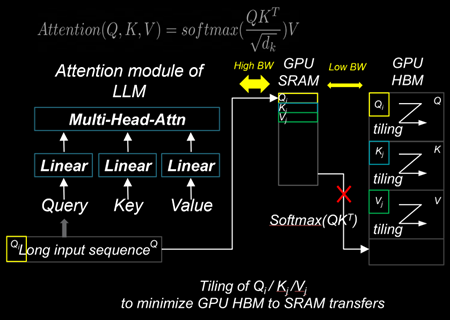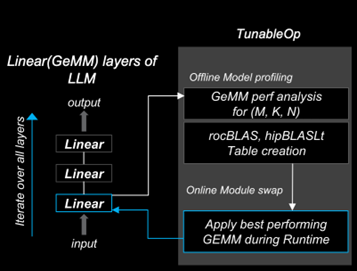Model acceleration libraries#
2024-06-05
12 min read time
This section discusses model acceleration techniques and libraries to improve memory efficiency and performance.
Flash Attention 2#
Flash Attention is a technique designed to reduce memory movements between GPU SRAM and high-bandwidth memory (HBM). By using a tiling approach, Flash Attention 2 improves memory locality in the nested loops of query, key, and value computations within the Attention modules of LLMs. These modules include Multi-Head Attention (MHA), Group-Query Attention (GQA), and Multi-Query Attention (MQA). This reduction in memory movements significantly decreases the time-to-first-token (TTFT) latency for large batch sizes and long prompt sequences, thereby enhancing overall performance.

Installing Flash Attention 2#
ROCm provides two different implementations of Flash Attention 2 modules. They can be deployed interchangeably:
ROCm Composable Kernel (CK) Flash Attention 2
OpenAI Triton Flash Attention 2
To install CK Flash Attention 2, use the following commands.
# Install from source
git clone https://github.com/ROCm/flash-attention.git
cd flash-attention/
GPU_ARCHS=gfx942 python setup.py install #MI300 series
Hugging Face Transformers can easily deploy the CK Flash Attention 2 module by passing an argument
attn_implementation="flash_attention_2" in the from_pretrained class.
import torch
from transformers import AutoModelForCausalLM, AutoTokenizer
device = torch.device("cuda:0" if torch.cuda.is_available() else "cpu")
model_name = "NousResearch/Meta-Llama-3-8B"
tokenizer = AutoTokenizer.from_pretrained(model_name, torch_dtype=torch.float16, use_fast=False)
inputs = tokenizer('Today is', return_tensors='pt').to(device)
model_eager = AutoModelForCausalLM.from_pretrained(model_name, torch_dtype=torch.float16, attn_implementation="eager").cuda(device)
model_ckFAv2 = AutoModelForCausalLM.from_pretrained(model_name, torch_dtype=torch.float16, attn_implementation="flash_attention_2").cuda(device)
print("eager GQA: ", tokenizer.decode(model_eager.generate(**inputs, max_new_tokens=10)[0], skip_special_tokens=True))
print("ckFAv2 GQA: ", tokenizer.decode(model_ckFAv2.generate(**inputs, max_new_tokens=10)[0], skip_special_tokens=True))
# eager GQA: Today is the day of the Lord, and we are the
# ckFAv2 GQA: Today is the day of the Lord, and we are the
The Triton Flash Attention 2 module is implemented in Python and uses OpenAI’s JIT compiler. This module has been upstreamed into the vLLM serving toolkit, discussed in :doc:’llm-inference-frameworks’.
To install Triton Flash Attention 2 and run the benchmark, use the following commands.
# Install from the source pip uninstall pytorch-triton-rocm triton -y git clone https://github.com/ROCm/triton.git cd triton/python GPU_ARCHS=gfx942 python setup.py install #MI300 series pip install matplotlib pandas
To test, run the Triton Flash Attention 2 performance benchmark.
# Test the triton FA v2 kernel python https://github.com/ROCm/triton/blob/triton-mlir/python/perf-kernels/flash-attention.py # Results (Okay to release TFLOPS number ???) fused-attention-fwd-d128: BATCH HQ HK N_CTX_Q N_CTX_K TFLOPS 0 16.0 16.0 16.0 1024.0 1024.0 287.528411 1 8.0 16.0 16.0 2048.0 2048.0 287.490806 2 4.0 16.0 16.0 4096.0 4096.0 345.966031 3 2.0 16.0 16.0 8192.0 8192.0 361.369510 4 1.0 16.0 16.0 16384.0 16384.0 356.873720 5 2.0 48.0 48.0 1024.0 1024.0 216.916235 6 2.0 48.0 48.0 2048.0 1024.0 271.027578 7 2.0 48.0 48.0 4096.0 8192.0 337.367372 8 2.0 48.0 48.0 8192.0 4096.0 363.481649 9 2.0 48.0 48.0 16384.0 8192.0 375.013622 10 8.0 16.0 16.0 1989.0 15344.0 321.791333 11 4.0 16.0 16.0 4097.0 163.0 122.104888 12 2.0 16.0 16.0 8122.0 2159.0 337.060283 13 1.0 16.0 16.0 16281.0 7.0 5.234012 14 2.0 48.0 48.0 1021.0 1020.0 214.657425 15 2.0 48.0 48.0 2001.0 2048.0 314.429118 16 2.0 48.0 48.0 3996.0 9639.0 330.411368 17 2.0 48.0 48.0 8181.0 1021.0 324.614980
xFormers#
xFormers also improves the performance of attention modules. Although xFormers attention performs very similarly to Flash Attention 2 due to its tiling behavior of query, key, and value, it’s widely used for LLMs and Stable Diffusion models with the Hugging Face Diffusers library.
Installing CK xFormers#
Use the following commands to install CK xFormers.
# Install from source
git clone https://github.com/ROCm/xformers.git
cd xformers/
git submodule update --init --recursive
PYTORCH_ROCM_ARCH=gfx942 python setup.py install #Instinct MI300-series
PyTorch built-in acceleration#
PyTorch compilation mode synthesizes the model into a graph and then lowers it to prime operators. These operators are compiled using TorchInductor, which uses OpenAI Triton as a building block for GPU acceleration. One advantage of PyTorch compilation mode is that its GPU kernels are written in Python, making modifying and extending them easier. PyTorch compilation mode often delivers higher performance, as model operations are fused before runtime, which allows for easy deployment of high-performance kernels.
PyTorch compilation#
To utilize the PyTorch compilation mode, specific layers of the model
must be explicitly assigned as compilation targets. In the case of LLM,
where autoregressive token decoding generates dynamically changing
key/value sizes, limiting the key/value size to a static dimension,
max_cache_length, is necessary to utilize the performance benefits
of the PyTorch compilation.
# Sample script to run LLM with the static key-value cache and PyTorch compilation
from transformers import AutoModelForCausalLM, AutoTokenizer, StaticCache
import torch
from typing import Optional
import os
device = torch.device("cuda:0" if torch.cuda.is_available() else "cpu")
os.environ["TOKENIZERS_PARALLELISM"] = "false"
model_name = "NousResearch/Meta-Llama-3-8B"
prompts = []
for b in range(1):
prompts.append("New york city is where "
)
tokenizer = AutoTokenizer.from_pretrained(model_name)
model = AutoModelForCausalLM.from_pretrained(model_name, torch_dtype=torch.float16).to(device).eval()
inputs = tokenizer(prompts, return_tensors="pt").to(model.device)
def decode_one_tokens(model, cur_token, input_pos, cache_position):
logits = model(cur_token, position_ids=input_pos, cache_position=cache_position, return_dict=False, use_cache=True)[0]
new_token = torch.argmax(logits[:, -1], dim=-1)[:, None]
return new_token
batch_size, seq_length = inputs["input_ids"].shape
# Static key-value cache
max_cache_length = 1024
max_new_tokens = 10
model._setup_cache(StaticCache, batch_size, max_cache_len=max_cache_length)
cache_position = torch.arange(seq_length, device=device)
generated_ids = torch.zeros(batch_size, seq_length + max_new_tokens + 1, dtype=torch.int, device=device)
generated_ids[:, cache_position] = inputs["input_ids"].to(device).to(torch.int)
logits = model(**inputs, cache_position=cache_position, return_dict=False, use_cache=True)[0]
next_token = torch.argmax(logits[:, -1], dim=-1)[:, None]
# torch compilation
decode_one_tokens = torch.compile(decode_one_tokens, mode="max-autotune-no-cudagraphs",fullgraph=True)
generated_ids[:, seq_length] = next_token[:, 0]
cache_position = torch.tensor([seq_length + 1], device=device)
with torch.no_grad():
for _ in range(1, max_new_tokens):
with torch.backends.cuda.sdp_kernel(enable_flash=False, enable_mem_efficient=False, enable_math=True):
next_token = decode_one_tokens(model, next_token.clone(), None, cache_position)
generated_ids[:, cache_position] = next_token.int()
cache_position += 1
PyTorch TunableOp#
ROCm PyTorch (2.2.0 and later) allows users to use high-performance ROCm GEMM kernel libraries through PyTorch’s built-in TunableOp options. This enables users to automatically pick up the best-performing GEMM kernels from rocBLAS and hipBLASLt libraries during runtime.
During warm-up runs or offline profiling steps, users can create a GEMM Table
that enumerates the kernel information. During the model’s run, the best-performing kernel substitutes
torch.nn.functional.linear(input, weight, bias=None) with the kernel specified in the GEMM table. The
Tunable GitHub
page describes the options.
# To turn on TunableOp, simply set this environment variable
export PYTORCH_TUNABLEOP_ENABLED=1
# Python
import torch
import torch.nn as nn
import torch.nn.functional as F
A = torch.rand(100, 20, device="cuda")
W = torch.rand(200, 20, device="cuda")
Out = F.linear(A, W)
print(Out.size())
# tunableop_results0.csv
Validator,PT_VERSION,2.4.0
Validator,ROCM_VERSION,6.1.0.0-82-5fabb4c
Validator,HIPBLASLT_VERSION,0.7.0-1549b021
Validator,GCN_ARCH_NAME,gfx942:sramecc+:xnack-
Validator,ROCBLAS_VERSION,4.1.0-cefa4a9b-dirty
GemmTunableOp_float_TN,tn_200_100_20,Gemm_Rocblas_32323,0.00669595

Learn more about optimizing kernels with TunableOp in Optimizing Triton kernels.